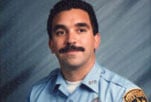George’s persistence helped save his life after his first pulmonary embolism was misdiagnosed and his initial DVT was not treated.
I reported for one of my 24 hour shifts as a Firefighter/Paramedic in November 2007. There was a carbon monoxide call that required me to be on a ladder for an extended time that meant I had to maintain a “leg lock,” which is a way a firefighter hooks a leg onto a ladder, so that she can work safely. It keeps hands free, and eliminates any danger of falling. On top of everything else that happened, I fell through a window on another call when I assisted an elderly woman who was stuck. I later noticed pain in the leg that I used in the “leg lock,” but passed it off as typical aches and pains of my job.
I was off duty the next day, but hung around to have coffee and share stories with the incoming crew, and went home shortly thereafter. Later that morning I felt congested, and coughed up bright red blood a couple of times. At first, I thought it was a bloody nose due to the dry heat in the firehouse. Then I noticed wet sounds in my lungs with my next breath, and I felt “gurgling” in my right lung along with the bright red blood. I knew something was very wrong at that point.
I went to the ER by ambulance, and tried to stay calm and to suppress any panic I felt enroute, because I could feel my heart rate increasing. At first, I was diagnosed with hemorrhagic bronchitis and a deep vein thrombosis (DVT) in my right leg, the same leg used in my leg lock, and was sent home on an antibiotic under the care of my primary care doctor. I was also told to take Tylenol and aspirin, although no blood thinners were ordered at this time.
This all seemed so strange to me, because I considered myself healthy, and did not have fever, shortness of breath, or other symptoms of bronchitis. Within the month, I started coughing up bright red blood again while I was watching TV. This was a repeat of the horrific feeling of gurgling in my lungs and my associated fear. Again, I was rushed to the ER, where I was admitted to the hospital by my primary doctor. A pulmonary angiogram showed a pulmonary embolism (PE) in the upper lobe of my right lung. This was actually a second PE, although the first was misdiagnosed as bronchitis, and this second one developed before I was able to see either a hematologist (blood disorder specialist) or pulmonologist (lung specialist), and I had not yet been put on Coumadin. I think I may have saved my own life because I knew enough to question the original diagnosis of bronchitis.
I was finally put on Coumadin which precipitated more bleeding in my lung, so a filter was placed in my inferior vena cava (IVC) to block more clots from entering my lungs, which was removed the following month, after my Coumadin was adjusted to keep my INR between 2.0 and 3.0. I was told to wear compression stockings at this point.
After the right dose of Coumadin was determined, I became stronger physically. I worked light duty for several months, which meant that I went on inspections. I also developed pleurisy or inflammation of the lung membranes, during which time it was more difficult to keep my INR steady.
I was taken to the ER again about 9 months after my first “missed” PE, because I started coughing up blood once again without any warning, this time while on Coumadin. I received 6 units of fresh frozen plasma, several doses of vitamin K, and underwent a coil embolization to treat a ruptured blood vessel in the region of my previous PEs. Typical causes of clots were ruled out, such as any inherited clotting disorders or cancer. There is no history of clotting disorders or blood clots in my birth family.
Later that same month, I felt unwell yet again, and I was advised by my doctor to return to the ER. A CAT scan showed multiple PEs: 5 in the left lung, 4 in the right lung.
My lung capacity is reduced to about 60%, and the circulation to my lower legs is limited. I continue to wear compression stockings, and will need Coumadin for the rest of my life. All of this started when I was only 37 years of age, fit, and without any health problems. It has been a long road. My fellow firemen think that because I do not show any physical disfigurement that there is nothing wrong with me. They don’t realize that PEs can be fatal, or how upsetting it is to me that blood clots ended a career that I loved.
I went from the life as a professional firefighter, with a high level of physical activity, and from someone who hiked, camped, and fished often to a sedentary life. My usual activity came to a screeching halt, due to pain in my chest where the coil is, leg pain, and persistent shortness of breath.
I want to stay vigilant to any change in my condition, and I see my life as an emotional, physical, and psychological obstacle course, which will not be easy.
Right now I am just happy to have made it to 41! I still get goose bumps and chills down my spine whenever I think of how close to the brink of death I was, and how lucky I am that I survived, despite a delay in a correct diagnosis.
Leg Lock Technique
A leg lock is a way of hooking a leg onto the ladder so that a firefighter can work safely from the ladder with his/her hands free while eliminating the danger of falling.
If a leg lock is not used, a firefighter must have at least one hand free to hold on to the ladder beam. No exceptions.
George Dennis, P.O.Box 8902, Albany, NY 12208 email: gdennis563@gmail.com




